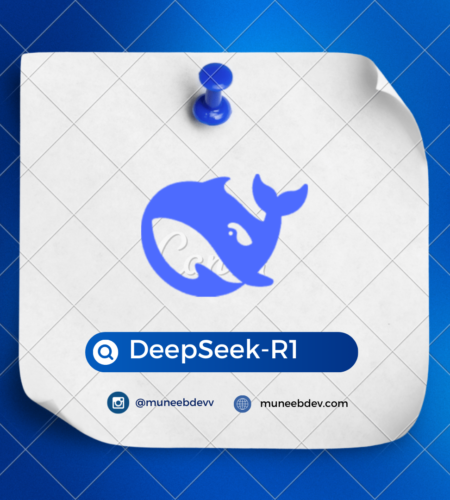Introduction
AI models today are increasingly used for solving complex problems like mathematics, programming, and even answering intricate questions. However, many of these models rely heavily on labeled data and predefined examples to perform well. Enter DeepSeek-R1, a model that rethinks how reasoning in AI works. It’s designed to go beyond traditional methods by focusing on Reinforcement Learning (RL) and optimizing its learning processes.
Let’s dive deeper into what makes DeepSeek-R1 special, the challenges it overcomes, and how it’s setting new benchmarks for reasoning in AI.
The Core of DeepSeek-R1
DeepSeek-R1 is not a single model but a framework for training reasoning-focused AI systems. It consists of two key versions:
- DeepSeek-R1-Zero:
- This version starts learning entirely from scratch using RL.
- It has no “pre-teaching” or labeled data to guide it initially.
- It discovers reasoning techniques naturally through trial and error, much like a child learning a game through exploration.
- This method leads to the emergence of surprising reasoning capabilities, such as:
- Reflection: Revisiting and refining answers.
- Verification: Checking the accuracy of solutions.
- Chain-of-Thought (CoT): Explaining reasoning in detailed steps.
- However, this approach also introduces challenges like language mixing (e.g., combining English and Chinese) and poor readability in responses.
- DeepSeek-R1:
- To address the limitations of R1-Zero, this version incorporates cold-start data.
- “Cold start” means using curated examples of high-quality reasoning to give the model a foundation before applying RL.
- After initial fine-tuning, RL is used to refine its capabilities further, resulting in:
- Clearer and more structured answers.
- Higher accuracy across benchmarks.
- Compatibility with human preferences (like readable formats and logical structures).
How DeepSeek-R1 Works
The training process for DeepSeek-R1 is divided into several stages:
1. Reinforcement Learning with DeepSeek-R1-Zero
DeepSeek-R1-Zero uses Group Relative Policy Optimization (GRPO), a type of RL that simplifies training by grouping responses and optimizing them together. This approach ensures the model:
- Learns efficient strategies for solving reasoning problems.
- Develops long reasoning chains that allow it to tackle complex tasks.
Rewards in RL:
- Accuracy Rewards: Points for getting correct answers, such as solving math problems or passing test cases in code.
- Format Rewards: Encourages structured responses, such as using tags to separate reasoning steps from final answers.
2. Cold Start for DeepSeek-R1
- High-quality examples (long reasoning chains, clear formats) are collected and used to give the model a starting point.
- This helps avoid the chaotic and unstable learning phase seen in R1-Zero.
3. Reasoning-Focused RL
Once the model has a solid foundation, it undergoes RL again, focusing on improving performance on reasoning tasks such as:
- Math challenges.
- Coding problems.
- Logical reasoning.
4. Rejection Sampling and Fine-Tuning
- Outputs from RL are evaluated and filtered. Only the best responses are used for additional fine-tuning.
- This phase also includes training on general tasks like writing and factual question answering to ensure versatility.
5. Distillation
- Larger models like DeepSeek-R1 are distilled into smaller versions.
- Distillation is a process where the knowledge of a big, powerful model is compressed into a smaller one.
- The smaller models are faster and more efficient but retain much of the reasoning capability.
Why DeepSeek-R1 Matters
- Superior Reasoning Capabilities:
- DeepSeek-R1 achieves groundbreaking results on various reasoning benchmarks, such as:
- AIME 2024 (Math Test): 79.8% pass rate, comparable to OpenAI’s advanced models.
- MATH-500: Scores 97.3%, demonstrating expertise in complex mathematical problems.
- Codeforces (Programming): Competes at an expert level, outperforming 96% of human participants.
- DeepSeek-R1 achieves groundbreaking results on various reasoning benchmarks, such as:
- Efficiency Through Distillation:
- By distilling its capabilities, DeepSeek-R1 produces smaller models (like the 7B and 14B versions) that still excel in reasoning tasks.
- These smaller models outperform many larger, non-reasoning-focused AI systems like GPT-4o and Claude-Sonnet.
- Emergent Behaviors:
- During training, the model develops behaviors that were not explicitly programmed, such as:
- Revisiting solutions for improvement (reflection).
- Using extended reasoning steps for better accuracy.
- During training, the model develops behaviors that were not explicitly programmed, such as:
- Open-Source Contribution:
- DeepSeek-R1 and its distilled models are open-sourced, allowing the research community to build upon its advancements.
Challenges Faced
- Readability Issues in Early Models:
- DeepSeek-R1-Zero often produced answers that were messy or hard to follow.
- Cold-start fine-tuning helped address this, but there’s room for improvement in handling multi-language scenarios.
- Prompt Sensitivity:
- The model struggles with “few-shot” prompts (examples included in the query).
- It works best in “zero-shot” mode, where users provide a direct question and request a specific output format.
- Software Engineering Tasks:
- While DeepSeek-R1 performs well in coding, its results on engineering-specific tasks like SWE-Bench remain average.
- Future updates aim to improve this through better training data.
Future of DeepSeek-R1
The research team behind DeepSeek-R1 plans to address these challenges and expand the model’s capabilities:
- Improving General Skills:
- Tasks like multi-turn conversations, advanced role-playing, and structured outputs (like JSON) will be refined.
- Language Adaptability:
- Expanding support for more languages while minimizing mixing issues.
- Smarter Prompts:
- Developing techniques to handle a wider variety of user queries more effectively.
- Enhanced Performance in Coding:
- Incorporating more coding-related RL data to make the model a strong tool for software development.
Conclusion
DeepSeek-R1 represents a shift in how AI models approach reasoning. By relying on reinforcement learning and distillation, it demonstrates that models can learn to think and reason at expert levels without excessive reliance on labeled data. Its ability to deliver high performance across tasks while also enabling efficient smaller models makes it a significant step forward in AI research.
DeepSeek-R1 isn’t just another AI model—it’s a glimpse into the future of reasoning-driven intelligence. Whether you’re solving math problems, debugging code, or answering complex questions, DeepSeek-R1 is shaping a smarter and more capable AI landscape.


Comments